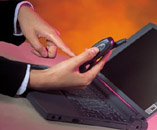Technology afftects communication methods |
 |
Technology provides a basis for different types of communication in distance education. Contemporary communication technology in distance education should support the following types of interaction:
- verbal and nonverbal content presentation and communication between individuals and groups;
- verbal and nonverbal social support and feedback for individuals and groups;
- communication, collaboration and functioning of the so-called social network within a group of participants
Many Learning Management Systems (LMS) have integrated different communication options, such as mailing list s, instant messaging , bulletin boards, newsgroups and forums, chat rooms etc.
While verbal communication requires nothing more than the use of textual ways of communication such as e-mail, chat rooms and/or discussion forums, a more complete nonverbal communication requires the use of audio and video channels of communication, synchronous or asynchronous.
It should be pointed out that, a more internsive use of sound or video records requires sufficiently fast Internet connection. Synchronous audio/video teleconferences are normally difficult or impossible to conduct when using a slow modem connection. W ebcasting also requires a fast Internet connection and appropriate equipment. It is interesting to note that the quantity of online video educational content ( video-on-demand ) is increasing with wider use of fast Internet connections.
Fast wireless access to LAN and the Internet ( wireless lan or Wi Fi ), as well as fast UMTS connection, the new generation of wireless telecommunication technology will enable webcasting and two-way audio/video communication from virtually any location at any time, which will significantly advance the teaching modalities and two-way communication between the instructor and the participants, as well as between the participants of online courses themselves.
Alterantive communication channels are recommended |
 |
When planning an online educational system the possibility of using several separate communication channels should be taken into consideration. The reasons for that are the following:
(a) individual participants may prefer or avoid a certain communication channel, e.g. some people prefer to use a more private communication through e-mail than through public discussion forums;
(b) sometimes the participants may need urgent information or help, e.g. if they cannot do or understand something related to the use of the online system, the assignments etc.;
(c) some messages are hard to convey or understand properly without face-to-face communication, i.e. using videoconferences or video records of the instructor’s/lecturer’s presentation.
It is especially important to enable the participants with urgent requests to receive a fast reply form the lecturer/instructor through alternative communication channels, such as instant messaging, mobile phones etc. The possibility of a video teleconferencing connection significantly contributes to communication, e.g. using NetMeeting .
Tips & tricks: Lecturer/instructor has access to many communication tools and means, especially if they do not focus their communication with the participants solely on what is offered within a certain LMS. For example, you can use systems such as IRC (Internet Relay Chat) or ICQ (I Seek You), services offered by Yahoo portal for online forums, NetMeeting program for videoconferences, SMS for urgent messages etc. In any case you should avoid situations in which the participants’ needs for learning or socialization are not timely met, as well as possible loss of their interest or trust because of inadequate or insufficient contact with the instructor.

